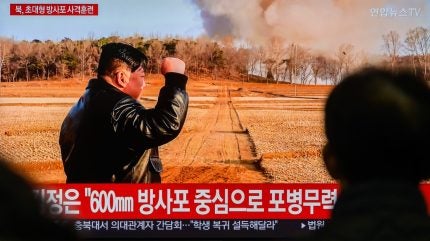
A recent spate of weapons drills in North Korea reflects deepening tensions between Pyongyang and Seoul, with analysts pinpointing the Korean Peninsula as one of the world’s highest-risk flashpoints.
On Tuesday (19 March), North Korean leader Kim Jong Un oversaw the successful test of the intermediate-range hypersonic missile at the Sohae Satellite Launching Ground, the state-run Korean Central News Agency reported.

Discover B2B Marketing That Performs
Combine business intelligence and editorial excellence to reach engaged professionals across 36 leading media platforms.
The day before, North Korea had reportedly fired three short-range ballistic missiles into the Sea of Japan while US Secretary of State Antony Blinken visited Seoul, which South Korea condemned as a “clear provocation”.
The launch followed one of the US and South Korea’s joint major annual military exercises, which Kim called an invasion rehearsal.
“Nuclear risk” in Korean Peninsula
Over the next four years, the risk of conflict escalation between North and South Korea is “high – with nuclear risk”, according to GlobalData analysts’ Geopolitics – Executive Briefing.

US Tariffs are shifting - will you react or anticipate?
Don’t let policy changes catch you off guard. Stay proactive with real-time data and expert analysis.
By GlobalDataWhile the briefing says the direct threat of ongoing conflicts in Ukraine and Gaza is severe, the ripple effect of escalating tensions in East Asia has the largest relative risk based on likelihood and global impact.
Christopher Granville, managing director of Global Political Research at TS Lombard, described East Asia as “the crunch point of the geopolitical tectonic plates”.
Within the East Asia theatre, the briefing designates Taiwan, the South China Sea and the Korean Peninsula as the major risks.
“So high are the stakes in the US-China confrontation that the economic and business risks stemming from the present Russia-Ukraine and Middle East wars would pale beside any possible conflicts in East Asia,” the briefing states. “[There is] explosive potential also on the Korean Peninsula and in the South China Sea”.
This analysis of fraught geopolitical relations on the Korean Peninsula correlates with the latest intensification in rhetoric and military activity.
Defence experts believe North Korea’s hypersonic missile tested on Tuesday (19 March) has the capacity to reach long-distance US targets, including military bases in the territory of Guam, parts of Alaska and Okinawa, Japan.
The missile tested on 19 March used a solid-fuel engine, which lasts longer than liquid-propelled missiles – and makes launches trickier to detect.
Given its proximity to the border with North Korea and the Korean Demilitarised Zone (DMZ), Seoul is also much more susceptible to a surprise attack than Pyongyang.
In a hypothetical trading of cross-border missiles, South Korea’s aerial defence protocol would have considerably less time to react than North Korea, especially if Pyongyang launched solid-fuel, tricky-to-detect missiles.
Nuclear warhead stockpiling
The briefing ranks designates conflict in Taiwan as a “moderate to high” risk compared to the Korean Peninsula’s “high” risk – and this is largely due to the potential for nuclear warfare.
In 2006, North Korea became the ninth country to demonstrate nuclear weapon capabilities, joining the US, Russia, UK, France, China, India, Pakistan and Israel.
Ever since, Pyongyang has forged closer military ties with Moscow.
While Russia and the US have reduced their nuclear arsenals since the peak in 1986, when the pair possessed an estimated combined 63,476 active warheads, other powers including China, India and Pakistan have added to their stockpiles.
North Korea has assembled an estimated thirty active nuclear warheads, according to Our World in Data.
This nuclear firepower, combined with Pyongyang’s recent move to formally abandon its long-standing goal of reunification with South Korea, has opened a dangerous chapter ahead in East Asian geopolitics.





